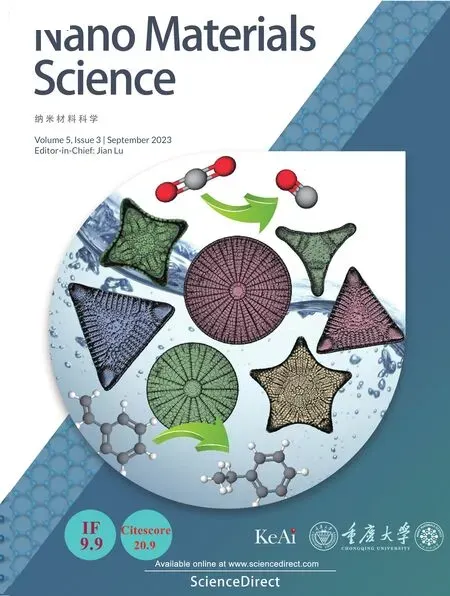Flexible and electrically robust graphene-based nanocomposite paper with hierarchical microstructures for multifunctional wearable devices
Zhen-Hu Tng ,Wei-Bin Zhu ,Jun-Zhng Chen ,Yun-Qing Li,b,** ,Pei Hung,b ,Kin Lio ,Sho-Yun Fu,b,*
a College of Aerospace Engineering,Chongqing University,Chongqing,400044,China
b State Key Laboratory of Power Transmission Equipment & System Security and New Technology,Chongqing University,Chongqing,400044,China
c Aerospace Engineering,Khalifa University,Abu Dhabi,127788,United Arab Emirates
Keywords:Graphene Bamboo fibers Microspheres Pressure sensors Joule heating devices
ABSTRACT Multifunctional and flexible wearable devices play a crucial role in a wide range of applications,such as heath monitoring,intelligent skins,and human-machine interactions.Developing flexible and conductive materials for multifunctional wearable devices with low-cost and high efficiency methods are highly desirable.Here,a conductive graphene/microsphere/bamboo fiber (GMB) nanocomposite paper with hierarchical surface microstructures is successfully fabricated through a simple vacuum-assisted filtration followed by thermo-foaming process.The as-prepared microstructured GMB nanocomposite paper exhibits not only a high volume electrical conductivity of~45 S/m but also an excellent electrical stability(i.e.,relative changes in resistance are less than 3% under stretching,folding,and compressing loadings) due to its unique structure features.With this microstructured nanocomposite paper as active sensing layer,microstructured pressure sensors with a high sensitivity(-4 kPa-1),a wide sensing range (0–5 kPa),and a rapid response time (about 140 ms)are realized.In addition,benefitting from the outstanding electrical stability and mechanical flexibility,the microstructured nanocomposite paper is further demonstrated as a low-voltage Joule heating device.The surface temperature of the microstructured nanocomposite paper rapidly reaches over 80 °C when applying a relatively low voltage of 7 V,indicating its potential in human thermotherapy and thermal management.
1.Introduction
Recently,smart wearable devices have attracted significant attention due to their potential applications in human healthcare,human-machine interactions,and smart robotics [1–4].It is known flexible conductive composites are one of critical component for most of wearable electronics,such as wearable sensors[5],personalized devices[6],as well as multifunctional flexible electronics [7],which should have high electrical conductivity,excellent mechanical flexibility,and electrical robustness to meet the practical requirements[1,7,8].
To date,various nanomaterials including carbon nanotubes (CNTs)[3,4,8,9],carbon nanofibers [10],metal nanowires (e.g.,AgNWs) [11],nanoparticles (e.g.,AgNPs) [12],and graphene nanosheets [13]have been widely used as conductive nanofillers to fabricate flexible conductive nanocomposites.Particularly,2D graphene,has emerged as a promising nanofiller for conductive nanocomposites ascribed to its high electrical conductivity,high mechanical strength,and unique 2D planner structure [14].Due to these unique properties,graphene-based conductive nanocomposites have been widely studied.For instance,Ruoff et al.prepared a graphene/polystyrene nanocomposite by solution mixing and followed by chemical reduction,which featured an ultralow percolation threshold of~0.1 vol%,but a moderate volume electrical conductivity of~0.1 S/m [14].Besides,by adding graphene into a lightly cross-linked polysilicone,highly conductive nanocomposites were obtained and used as sensitive electromechanical sensors for monitoring pulse,blood pressure,and impact[13].However,the nanocomposite displays a poor electrical stability.
In addition to the above-mentioned graphene-filled conductive nanocomposites,as an ultrathin membrane-like material,graphene nanosheet can easily be assembled onto various substrates due to van der Waals forces,which makes it become an ideal material for constructing highly conductive nanocomposites [15,16].In this regard,graphene nanosheets have been assembled into conductive films by vacuum-assisted filtration methods,which exhibit ultra-high conductivities and widespread applications in diverse electronic devices such as sensors [16],supercapacitors [17],and electromagnetic shielding [18].Indeed,this fabrication method is simple,low-cost,and effective,but the obtained highly conductive nanocomposites usually showed poor electrical stability under external mechanical loadings,such as stretching,folding,and compressing [16,19].Furthermore,as an increasingly popular approach,flexible conductive nanocomposites with surface microstructures can be compressed more easily,which have great potential in high-performance wearable pressure sensors [20–23].Although photolithography and microtemplating techniques have been frequently used to fabricate graphene-based conductive nanocomposites with diverse microstructures for wearable pressure sensors[20–23],these fabrication methods are quite complicated and time consuming,which is one of the biggest challenges for practical use.It seems that it is impossible to prepare microstructured conductive materials through a simple approach such as vacuum-assisted filtration.Moreover,because of the mechanical instability of the microstructures,most previously reported microstructured nanocomposites cannot exhibit satisfactory electrical and mechanical stability [22,23].Consequently,despite significant progress has been achieved in the field of graphene-based conductive composites,it is,to date,still great challenging to fabricate graphene-based nanocomposites with surface microstructures,high conductivity,and excellent electrical stability simultaneously via a simple and facile fabrication strategy.
Herein,targeted for multifunctional wearable applications,hierarchically microstructured graphene-based nanocomposites featured with high conductivity and electrical robustness were successfully fabricated with a low-cost and facile vacuum-assisted filtration method followed by post thermo-foaming,in which natural-sourced bamboo fibers are utilized as skeletons,and graphene and thermally expanding microspheres(TEMs) serve as conductive fillers and surface microstructure initiators,respectively.The application of bamboo fiber as skeleton is emerging due to its various merits such as low price,light weight,sustainable nature,and environmental friendly.Because of the unique thermal expansion property of TEMs,hierarchical rough surface is easily produced via a facile post-processing strategy.Owing to the compact network feature caused by expanding extrusion of TEMs,the microstructured GMB nanocomposite paper obtained exhibits excellent electrical robustness under stretching,folding,and compressing stimuli.Based on these exceptional electrical properties and unique microstructure feature of the microstructured GMB papers fabricated,a microstructured pressure sensor is assembled,and its pressure-sensing properties are investigated in detail.Taking advantage of the hierarchical surface feature,the resultant pressure sensor shows a high sensitivity of-4 kPa-1and a wide sensing range of 0–5 kPa.Besides,based on the excellent electrical properties of the microstructured GMB paper,a highly effective and flexible Joule heating device is also demonstrated.The surface temperature rapidly reached more than 80°C under an input voltage of 7 V,indicating great potential in the fields of thermotherapy and personal thermal management.The technique presented may pave a facile way to fabricate microstructured composites for various electronic devices.
2.Experimental section
2.1.Materials and fabrication
Natural bamboo(Phyllostachys edulis)was used for the fabrication of bamboo fibers by a chemical treatment method in this study.Sodium hydroxide and sodium hypochlorite were obtained from Chongqing Chuandong Chemical Inc.China.An aqueous dispersion of graphene with a concentration of 1 wt% was purchased from Chengdu Organic Chemicals Co.Ltd.China.The lateral size of graphene ranged from 4 to 6 μm,and the number of layers was less than 10.The TEMs(Clocell 120DU25)with an average diameter of 15 μm were obtained from PolyChem Alloy(USA).TEM is a thermally expanding microsphere of liquid hydrocarbon surrounded by a thick thermoplastic resin shell.The thermoplastic shell softens upon heat,whereas the hydrocarbon undergoes a phase change to gas,and thus the volume of the microspheres increases considerably.When the heating stops,the thermoplastic shell cools down and its shape remains [24].All materials were used as received without further purification.
Bamboo fibers were fabricated according to the method previously reported[25].Briefly,bamboo slices were directly immersed in sodium hydroxide solution(2.5 mol/L)for hydrothermal treatment at 170°C for 6 h to remove the lignin.Followed by decolourization with sodium hypochlorite solution (2.5 M).Then the bamboo pulps obtained were rinsed with deionized (DI) water until the pH value was about 7.After that,the bamboo pulps were further washed with DI water to remove the chemicals.Finally,the bamboo fibers were obtained via freeze-drying.
The GMB papers were prepared by a simple vacuum-assisted filtration method.Typically,different mass ratios of TEMs,graphene,and bamboo fibers were gradually added into~100 mL DI water and fully mixed by magnetic stirring at room temperature.Subsequently,the uniformly dispersed ternary mixture was directly filtered through a polytetrafluoroethylene filter membrane with a pore diameter of 45 μm to fabricate the GMB papers.After drying and peeling off from the filter membrane,the microstructured GMB paper was finally obtained by thermo-foaming at 110°C for about 10 min.For simplicity,the resultant microstructured GMB paper was noted as m-GMB paper.Different m-GMB papers were obtained by tuning the mass contents of TEMs but fixing the masses of graphene (60 mg) and bamboo fibers (120 mg).Table 1 lists the corresponding mass fractions of TEMs and graphene for different samples.Pure bamboo fiber paper,without addition of graphene and TEMs,was also prepared for comparison purpose.

Table 1The corresponding concentrations of TEMs and graphene for different representative samples.
To fabricate the flexible pressure sensor,aluminum foils as external electrodes were attached to the surface of the m-GMB papers with the assistance of electrically conductive silver pastes.Then the pressure sensor was constructed by assembling two m-GMB papers into a face-toface structure.To fabricate the flexible Joule heating device,aluminum foils were connected to both the ends of a m-GMB paper.
2.2.Characterizations and measurements
The morphologies the m-GMB papers were characterized by a scanning electron microscope (SEM,Phenom XL,China).All electrical measurements were conducted using a digital source meter (KEYSIGHT 34465A,USA).X-ray photoelectron spectra(XPS)were characterized by using a photoelectron spectrometer (Thermo ESCALAB 250XI).The sensing performance of the fabricated pressure sensors was carried out with a testing machine (Shimadzu AGS-X,Japan),while the output electrical signals were recorded by the digital source meter.The temperature and infrared thermal images of the Joule heating devices were recorded by using an infrared thermometer(FLIR E4,USA).The relative changes in resistance of the pressure sensors is determined with ΔR/R0=(R-R0)/R0,whereR0andRis the initial resistance and the real-time resistance during loading,respectively [26].The sensitivity (gauge factor:GF)of the pressure sensor is defined as the slope of the curve of the relative resistance change versus the applied pressure (P),that is,GF=(ΔR/R0)/P.
3.Results and discussion
3.1.Fabrication and characterizations
Fig.1a illustrates the fabrication process of the m-GMB nanocomposite papers.First,bamboo pulp was fabricated through removing the lignin in natural bamboo by a hydrothermal treatment process,and then the bamboo fibers comprised of cellulose bundles were directly prepared by freeze-drying.Note that the bamboo fibers had a diameter ranging from 8 to 15 μm,and their length was typically up to several millimeters to dozens of millimeters,corresponding to an aspect ratio of approximately 1000 [25].Subsequently,a certain amount of bamboo fibers,TEMs,and graphene aqueous dispersion were gradually added into DI water,and after fully mixed by magnetic stirring overnight,the m-GMB papers were prepared by vacuum-assisted filtration followed by thermo-foaming.The optical images of the as-prepared m-GMB paper(Sample #3) are exhibited in Fig.1b,indicating a good mechanical flexibility of the m-GMB paper.The resultant m-GMB paper as active conducting material may have great application potential in the field of wearable devices,such as flexible pressure sensor and personal heating device,as illustrated in Fig.1c.
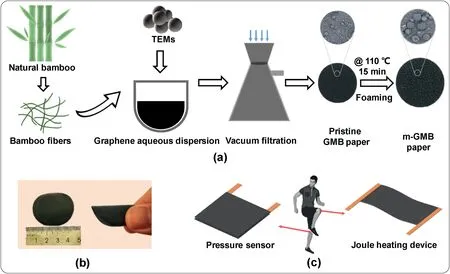
Fig.1.(a) Schematic illustration of the fabrication processes of the m-GMB paper.(b) Optical images of the prepared m-GMB paper,indicating its mechanical flexibility.(c) Schematic illustration showing the potential applications of the fabricated m-GMB papers.
Graphene (see Fig.2a) is widely utilized because of its exceptional properties,such as ultrahigh conductivity,strong mechanical strength,and large specific surface area,which could significantly improve the electrical and mechanical properties of the composites[17–19].Natural bamboo fibers were selected as skeleton material due to they have abundant surface functional groups (such as–OH and C–O) which can promote their interaction with graphene nanosheets through hydrogen-bonding [25].TEMs were utilized as surface microstructure initiators because they have large thermal expansion ratios [27].As shown in Fig.2b and c,when heating the TEMs to an elevated temperature,their volume increased considerably.After the heating was stopped,the TEMs cooled down and maintained at the expanding state[24].Thus,a hierarchical rough surface consisting of abundant micropapillae can be formed by controlling the expansion of TEMs.As shown in Fig.2d,the pure bamboo fiber paper exhibits a relatively flat and smooth surface feature as compared to the m-GMB paper(Sample#3,see Fig.2e and f).While,as shown in Fig.2e,a lot of expanded microspheres with diameters of about several tens of micrometers are observed at the surface of the m-GMB paper,indicating its uneven surface feature.From the higher magnification SEM image(Fig.2f),it also can be observed that the surface of the microspheres possesses a thin wrinkle structure,which was caused by the assembling of graphene nanosheets.The self-wrinkling of graphene on substrates has been reported previously [20–22].These microsphere protuberances and wrinkles significantly increase the surface roughness and can be modeled as a hierarchical surface structure,which is critical for the fabrication of high-performance pressure sensors[22,23].The cross-sectional SEM image in Fig.2g reveals that the m-GMB paper exhibits a compact stacked structure.The thickness of m-GMB paper is approximately 200 μm.
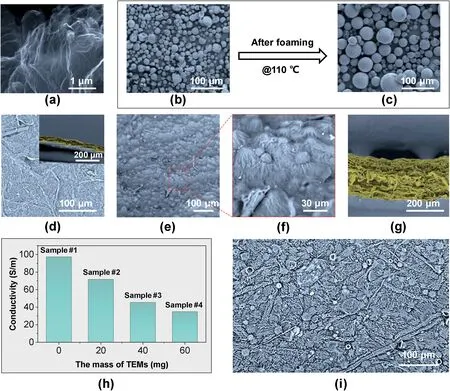
Fig.2.SEM images of(a)graphene,(b)pristine TEMs,and(c)expanded TEMs,(d)the surface and cross-section(inset)of bamboo fiber paper without TEMs,(e)and(f) the surface of the m-GMB paper (Sample #3),and (g) the cross-section of the m-GMB paper (Sample #3).(h) Electrical conductivity of the m-GMB papers as a function of TEM content.(i) SEM image of the surface of the m-GMB paper (Sample #2) fabricated with a low TEM content.
To demonstrate the effect of TEM content on the electrical conductivity of the m-GMB papers,a series of m-GMB papers with different TEM contents were fabricated (Table 1).As shown in Fig.2h,the electrical conductivity of the m-GMB papers decreases from~97 S/m to~35 S/m with increasing the TEM content from 0 to 60 mg,indicating a negative effect on the electrical conductivity.It is worth mentioning that the samples with more than 60 mg TEMs are not recommended for use since they are brittle and easily broken even when handled gently.Additionally,as shown in Fig.2i,the m-GMB paper(Sample#2)with a lower TEM content shows a smaller surface roughness.Therefore,by taking the microstructure and performance of the m-GMB papers into consideration,the samples with 18.18 wt%TEMs were selected in the subsequent experiments if not mentioned specifically(i.e.,Sample#3).
The chemical compositions of the bamboo fibers and m-GTB papers were further investigated by using XPS analysis.Fig.3a and b shows that two peaks of C and O appear in all samples.Fig.3c shows a highresolution C 1s XPS spectrum of the bamboo fibers,which confirms the presence of three main components: C–C bond (284.8 eV) in cellulosic structure,C–O groups is derived from C–OH groups of cellulose,and CO/O–C–O comes from lignin and cellulose.For the m-GTB papers,the C 1s peak can be curved-fitted with four peak components at the binding energy of about 284.8,285.4,286.5,and 288.2 eV (Fig.3d).These are attributed to C–C,C–OH,C–O,and CO/O–C–O,respectively.The C–O ratio of the m-GTB paper is larger than that of the bamboo fibers and a small shoulder at 285.4 eV emerges.This means that abundant hydrogen bonds were formed between bamboo fibers and graphene,as a result provided a much strong interface interaction.

Fig.3.XPS spectra of (a) the bamboo fibers and (b) the m-GTB papers.High-resolution C 1s spectra of (c) the bamboo fibers and (d) the m-GTB papers.
3.2.Electrical properties of the m-GMB paper under various mechanical stimuli
The typical stress-strain curves of the GMB and m-GMB papers are shown in Fig.4a.It can be seen that the tensile strength of the m-GMB paper is about 6.3 MPa,which is much higher than that of the un-foamed GMB paper(3.5 MPa),indicating that the expansion of TEMs endows the enhancement in tensile resistance.This mechanical enhancement is due to the tight contact among the TEMs and BFs caused by the expansion of the TEMs,thereby hindering the sliding between the BFs.From this figure,it also can be noted that the Young's modulus of the m-GMB paper is much larger than that of the un-foamed GMB paper.This phenomenon can be ascribed to the expansion of TEMs results in the increase of compactness of the m-GMB paper [24].Investigating the electrical properties of the as-prepared m-GMB paper under diverse mechanical loadings such as stretching,folding,and compressing,is important for multifunctional applications,owing to these mechanical stimuli are ubiquitous in engineering practice.Fig.4b shows the relative changes in resistance of a single m-GMB paper as a function of the tensile stress.From this figure,it can be seen that the relative resistance variation is less than 2% when tensile stress ranging from 0 to 2.3 MPa,showing a negligible sensitivity to tensile stress.In addition,the compressing sensitiveness of the m-GMB paper was also investigated.As shown in Fig.4c,the electrical resistance of the m-GMB paper decreases when increasing the pressure.With pressure increases from 0 to above 6 kPa,the relative resistance change is less than 3%.The decline of the resistance upon compressing loading suggested that there is no breakdown of the conductive pathways instead of the reconstruction of the conductive networks inside the specimen.Finally,to evaluate the effect of the folding deformation on the electrical resistance of the single m-GMB paper,the relative resistance variation under different folding angles was also measured.As indicated in Fig.4d,as the folding angle increases from 0 to 90°,the relative resistance change of the m-GMB paper is less than 3%,exhibiting a folding insensitive property.These experimental results indicated that the m-GMB papers show a remarkable electrical robustness against stretching,compressing,and folding loadings,which can be utilized as flexible conductive elements for sensors and other electronic devices.

Fig.4.(a) Stress-strain curves of GMB and m-GMB papers.Relative changes in resistance of the single m-GMB paper under (b) stretching,(c) compressing and (d)folding loadings.
3.3.Microstructured pressure sensor based on the m-GMB papers
According to previously reported studies [20–23,28–32],pressure sensors prepared using active sensing materials with surface microstructures enabled a wide working range and a high sensitivity.As a proof of concept,a face-to-face structural pressure sensor was constructed based on the m-GMB papers fabricated.The overall working mechanism of the microstructured pressure sensor developed is based on the contact resistance change between the bottom and top active sensing layers[22,23].The surface microstructures help the active sensing layer to elastically deform easily under external pressure and to enhance the sensing performance.Fig.5a shows the schematic illustration of the working mechanism of the microstructured pressure sensor.For the pressure sensor without pressure loading(initial state),a relatively small contact area between the bottom and the top active layers is formed due to the hierarchical microstructures of m-GMB papers,which results in a relatively high initial resistance(R0).With an external pressure applied,the m-GMB papers are compressed against each other,leading to an increase in the contact area/points between the two m-GMB papers to form a large number of tunnel junctions.Accordingly,more electrons can easily pass through the tunnel junctions,which causes an appreciable decreasing in the resistance of the sensor device,as shown in Fig.5b.
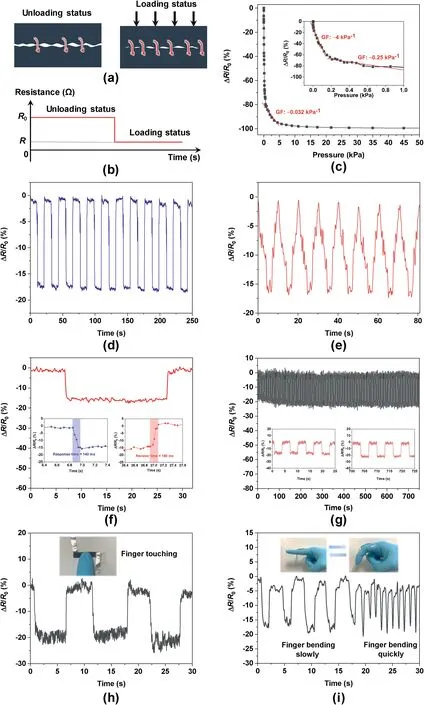
Fig.5.Pressure sensor demonstrations.(a)Schematic illustration of the cross-sectional view of the pressure sensor before and after the application of pressure and(b)the corresponding resistance changing with pressure loading.The responses of relative changes in resistance of the pressure sensor to various loading: (c) linear pressure from 0 to 50 kPa,(d)cyclic compressing/holding/releasing loadings(~50 Pa),(e)repeated compressing/releasing cycles with a peak pressure of~50 Pa.(f)Response and recover time of the pressure sensor,the insets display magnified views showing the drop and rise time.(g) The response of the pressure sensor under long-term compressing/releasing cycles with a peak pressure of~70 Pa.Applications of the pressure sensor for the detection of various mechanical stimuli including(h) gentle touching and (i) joint bending.
Fig.5c shows the electrical resistance response of the microstructured pressure sensor based on m-GMB papers as a function of the applied pressure ranging from 0 to 50 kPa.The inset of Fig.5c shows the enlarged resistance response in the low pressure range of 0–1 kPa.As seen from this figure,the response curve shows a typical negative piezoresistive behavior,and the pressure sensor exhibits a higher sensitivity of -4 kPa-1in the linear low-pressure regime (<0.2 kPa),a moderate sensitivity of-0.25 kPa-1in the medium-pressure range of 0.2–1 kPa,and a low sensitivity of -0.032 kPa-1in the high-pressure range (2–5 kPa).With the increase of the applied pressure,the deformation of the surface microstructures tends to saturated,thus,the sensitivity of the sensor device decreases under high applied pressures.As the applied pressure exceeds~5 kPa,the pressure sensor exhibits a negligible resistance change.Notably,the sensitivity of the device is significantly improved when compared with previous studies[31–36],which can be attributed to the unique hierarchical microstructures of the m-GMB papers.Table 2 lists the key sensing parameters of our sensor and the previously reported microstructured pressure sensors.As far as we known,a pressure sensor with a high sensitivity in a wide linear range is scarcely reported.As summarized in Table 2,although several previous pressure sensors showed a relatively wide linear sensing range up to 1 kPa,the sensitivity was less than-0.5 kPa-1[31,32].Our pressure sensor exhibits a higher sensitivity of-4 kPa-1in the low-pressure regime,which is comparable with the results reported in literature.For practical applications,the higher sensitivity in the low-pressure range is more crucial since the sensing of lower pressures does require a high-resolution to obtain an accurate response.

Table 2Comparison of the key sensing parameters of the present pressure senor with previously reported microstructured pressure sensors.
Fig.5d shows the responses of the pressure sensor prepared to a quasisquare wave (compressing/holding/releasing) pressure input.As revealed by the figure,the pressure sensor shows a remarkable reproducibility and stability.Furthermore,the response performance of the pressure sensor upon applying a triangular pressure profile was also investigated.As shown in Fig.5e,each dynamic response curve is continuous and stable without significant signal loss under repeated loading/unloading processes,indicating a stable sensing performance and an excellent repeatability.In addition,both rapid response time(140 ms) and recovery time (180 ms) of our pressure sensor can be observed in Fig.5f,which are similar to the reaction time of human skin.Compared to the dynamic response time,there is a small hysteresis during the recover process.This hysteresis of recovery time is possibly because of the elastic recovery of the GMB paper.Finally,to further demonstrate the stability and reliability of the pressure sensor,the longterm cyclic response of the pressure sensor was also measured under a pressure of 70 Pa for approximately 12 min,and the results are plotted in Fig.5g.As revealed by the figure,the output signals exhibit a good repeatability,indicating an excellent cycling stability of the pressure sensor for long-term use.
To demonstrate the utility of the pressure sensor in wearable devices,the as-prepared pressure sensor was applied to monitor diverse physiological activities of human body.As shown in Fig.5h,the pressure sensor can be used to detect finger tapping operation.When a finger was placed on the top of the pressure sensor,the output resistance decreased immediately.After released from the sensor,the resistance returned to its initial values quickly.Thus,the pressure sensor developed here is promising as an electronic skin to detect the grabbing force in robotic hands.Furthermore,as another demonstration,the pressure sensor was directly attached to a finger to detect its bending motions.Fig.5i shows the real-time resistance change of the sensor during finger bending operation.The finger bending movements are real-time detected because the sensor experiences compressive stress during bending operation.It can be seen that the slow and rapid bending movements could be distinguished from the output signals.The pressure sensor shows a stable response to the movement of the finger,indicating that the pressure sensor has a great application potential in gesture recognition.
3.4.Flexible heating device based on the m-GMB papers
Recently,flexible resistive heaters based on Joule effect have attracted remarkable attention due to their extraordinary potential in personal thermal management[37,38].In this regard,a highly flexible conducting element that can retain the electrical conductivity under various mechanical deformations is a key factor for successful development of wearable heaters.Based on the outstanding electrical robustness of the m-GMB paper under stretching,folding,and compressing loadings.The as-prepared flexible m-GMB paper has great potential in the field of wearable thermal management.When a voltage is applied to the both electrodes of the flexible m-GMB paper-based heating device,there is an electrical current that passes through.The m-GMB paper would produce Joule heat.Here,the m-GMB paper was connected to a DC power supply,and the surface temperature distribution was measured and recorded by an infrared camera.Fig.6a shows the real-time temperature changes of the m-GMB paper by applying various voltages(2,4,5,6,and 7 V).It can be seen that the maximum saturation temperature increases with increasing the applied voltage.For instance,under the applied voltage of 4 V,the surface temperature increases to about 41.6°C within 10 s and subsequently reaches to an equilibrium status.When the voltage increases to 7 V,the saturation temperature of the m-GMB paper increases to about 82.2°C.The time-temperature curves can be divided into two regimes of temperature-rising and -keeping.In the first one,the temperature increases rapidly,while in the second regime,the temperature tends to saturation.The temperature versus time can be empirically described by the following expression[39]:
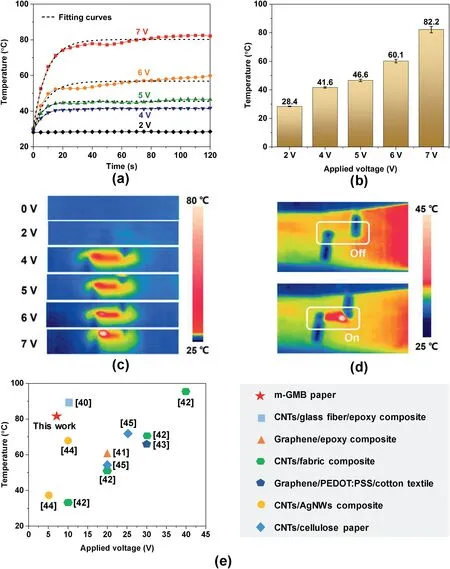
Fig.6.Joule heating performance of the m-GMB paper.(a) Time-temperature curves of the m-GMB paper under different applied voltages (2,4,5,6,and 7 V).(b)Saturation temperature variation with the increasing of voltage.(c)Infrared thermal images of the flexible m-GMB paper heater under different applied voltages.(d)Infrared thermal images showing the temperature distribution of the flexible m-GMB paper heater attached on an arm at 5 V.(e) Performance comparison of the flexible m-GMB Joule heating device with other previously electric heating composites [40–45].
whereTis the real-time temperature,τ is the characteristic time constant,andT0andTsare the initial and saturation temperature,respectively.As seen from Fig.6a,the above equation fitted well with the experimental temperature versus time curves.The calculated values of τ for the m-GMB heater under different applied voltages are found to be quite low(~6.3 s<τ <~9.5 s),indicating that the m-GMB nanocomposite papers have a very rapid temperature responsiveness to external voltages due to the effective conductive networks.In the second regime (i.e.,temperaturekeeping),based on the conservation law of energy,the heat gain by the supplied power is equal to the heat loss by radiation and convection,thus,the temperature remains unchanged.
The saturation temperature of the m-GMB paper versus the voltage ranging from 2 to 7 V is exhibited in Fig.6b.It could be seen that the m-GMB paper heater possesses an outstanding Joule heating performance and the saturation temperature can be easily adjusted by changing the applied voltage.In addition,the infrared thermal images of the m-GMB paper at various applied voltages are shown in Fig.6c.Obviously,the maximum surface temperature of the m-GMB paper increases with the applied voltage increases.The electrical powerPassociated with the flow of a current(I)under an applied voltage(V)is given byP=VI.According to Ohm's law,Pcan be rewritten asP=V2/R.Therefore,the heat caused by the electrical power is quadratically proportional to the applied voltage.Thus,it is reasonable to content that the maximum saturation temperature versus voltage follows the quadratic increasing trend.
Combining the electrical stability,mechanical flexibility and excellent Joule heating performance,the m-GMB paper was attached to a human body to show the potential for personal thermal management.As shown in Fig.6d,the flexible m-GMB paper can compliantly attached to the arm.After applying a voltage of 5 V with 10 s (bottom image in Fig.6d),the surface temperature of the m-GMB paper heater was reached to about 45°C,indicating that the m-GMB paper are promising for thermotherapy,body warming,and so forth.Besides,it should be mentioned that the m-GMB paper yielded a heating temperature of over 80°C under a relatively lower working voltage of 7 V,which exhibits better thermoelectrical performance compared with previously reported composite-based Joule heating devices as shown in Fig.6e.
4.Conclusions
In summary,a highly flexible graphene-based nanocomposite paper with excellent electrical properties has been successfully fabricated via a simple and low-cost vacuum-assisted filtration followed by thermofoaming process.The expansion of the incorporated TEMs successfully led to the formation of hierarchical microstructures.The as-prepared m-GMB paper showed an outstanding electrical stability under various mechanical loadings (i.e.,stretching,folding,and compressing).Taking advantage of the unique surface microstructure and the robust electrical performance,the m-GMB papers were used to construct microstructured pressure sensors which exhibited a relatively high sensitivity(-4 kPa-1in the linear range of 0–0.2 kPa),a large sensing range(0–5 kPa),a rapid response time (approximately 140 ms),and a good cyclic stability.In addition,the flexible m-GMB paper obtained also showed an outstanding Joule heating behavior due to its highly electrical conductivity.The surface temperature could quickly increase to more than 80°C at a relatively low applied voltage of 7 V,showing promising potential in wearable thermal management devices.This study provides a simple and effective strategy for the development of flexible and electrically robust conductive nanocomposites which are promising for wearable pressure sensors and thermal management devices.
Declaration of competing interest
There are no conflicts to declare.
Acknowledgements
We gratefully acknowledge the National Natural Science Foundation of China (Nos.11872132,51803016 and U1837204),the China Postdoctoral Science Foundation (No.2020M673124),the Natural Science Foundation of Chongqing (No.cstc2020jcyj-bshX0001),and the Competitive Internal Research Award of Khalifa University(CIRA-2018-16).
- Namo Materials Science的其它文章
- A novel strategy of constructing 2D supramolecular organic framework sensor for the identification of toxic metal ions
- PtZn nanoparticles supported on porous nitrogen-doped carbon nanofibers as highly stable electrocatalysts for oxygen reduction reaction
- Piezoresistive behavior of elastomer composites with segregated network of carbon nanostructures and alumina
- Surface reconstruction,modification and functionalization of natural diatomites for miniaturization of shaped heterogeneous catalysts
- DFT study on ORR catalyzed by bimetallic Pt-skin metals over substrates of Ir,Pd and Au
- Constructing P-CoMoO4@NiCoP heterostructure nanoarrays on Ni foam as efficient bifunctional electrocatalysts for overall water splitting

